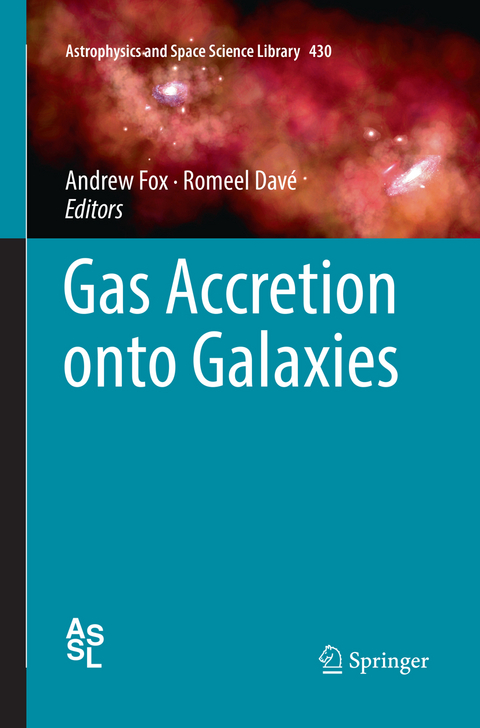
Gas Accretion onto Galaxies
Springer International Publishing (Verlag)
978-3-319-84920-1 (ISBN)
This edited volume presents the current state of gas accretion studies from both observational and theoretical perspectives, and charts our progress towards answering the fundamental yet elusive question of how galaxies get their gas. Understanding how galaxies form and evolve has been a central focus in astronomy for over a century. These studies have accelerated in the new millennium, driven by two key advances: the establishment of a firm concordance cosmological model that provides the backbone on which galaxies form and grow, and the recognition that galaxies grow not in isolation but within a "cosmic ecosystem" that includes the vast reservoir of gas filling intergalactic space. This latter aspect in which galaxies continually exchange matter with the intergalactic medium via inflows and outflows has been dubbed the "baryon cycle". The topic of this book is directly related to the baryon cycle, in particular its least well constrained aspect, namely gas accretion.
Accretion is a rare area of astrophysics in which the basic theoretical predictions are established, but the observations have been as yet unable to verify the expectations. Accretion has long been seen around the Milky Way in so-called High Velocity Clouds, but detecting accretion even around nearby galaxies has proved challenging; its multi-phase nature requires sensitive observations across the electromagnetic spectrum for full characterization. A promising approach involves looking for kinematic signatures, but accretion signatures are often confused with internal motions within galaxies.
Accretion studies therefore touch a wide range of astrophysical processes, and hence a wide cross-section of the astronomical community. As observational facilities are finally able to access the wavelength ranges and depths at which accretion processes may be manifest, the time is right to survey these multiple lines of investigation and determine the state of the field in accretion studies ofthe baryon cycle.Andrew Fox is an ESA/AURA astronomer at the Space Telescope Science Institute (STScI) in Baltimore, Maryland. His research focuses on the study of gas in and around galaxies and its role in controling galactic star-formation rates. He is experienced in the use of spectroscopy to characterize diffuse astrophysical gas, particularly in the Milky Way and the Magellanic Clouds. He recently co-authored an invited review on the Magellanic Stream in the Annual Reviews of Astronomy and Astrophysics. Before joining the staff at STScI in 2011, he held postdoctoral fellowships at the Institut d'Astrophysique de Paris in France and the European Southern Observatory in Chile, and spent time as a visiting scientist at the University of Cambridge.
1.An Introduction to Gas Accretion onto Galaxies.- 2.Gas Accretion onto the Milky Way.- 3.Neutral Gas Accretion onto Nearby Galaxies.- 4.Gas Accretion and Star Formation Rates.- 5.Gas Accretion Traced in Absorption in Galaxy Spectroscopy.- 6.Gas Accretion via Lyman Limit Systems.- 7.Gas Accretion in Star-Forming Galaxies.- 8.The Circumgalactic Medium in Massive Halos.- 9.Gas Accretion and Giant Lya Nebulae.- 10.Gas Accretion and Galactic Chemical Evolution: Theory and Observations.- 11.Gas Accretion and Angular Momentum.- 12.Observational Diagnostics of Gas Flows: Insights from Cosmological Simulations.- 13.The Effect of Galactic Feedback on Gas Accretion and Wind Recycling.- 14.Gas Accretion via Condensation and Fountains.- 15.Gas Accretion and Star-Formation Rates with IFUs and Background Quasars.
"Each chapter is written by a different author, a person very knowledgeable in the topic covered by their respective chapter and I was glad to see that very recent research was also included in the discussion ... . I would recommend this book to someone seeking an in-depth overview of a topic covered in the book ... ." (Electra Panagoulia, The Observatory, April, 2018)
“Each chapter is written by a different author, a person very knowledgeable in the topic covered by their respective chapter and I was glad to see that very recent research was also included in the discussion … . I would recommend this book to someone seeking an in-depth overview of a topic covered in the book … .” (Electra Panagoulia, The Observatory, April, 2018)
| Erscheint lt. Verlag | 25.7.2018 |
|---|---|
| Reihe/Serie | Astrophysics and Space Science Library |
| Zusatzinfo | XIX, 373 p. 102 illus., 95 illus. in color. |
| Verlagsort | Cham |
| Sprache | englisch |
| Maße | 155 x 235 mm |
| Gewicht | 6692 g |
| Themenwelt | Naturwissenschaften ► Physik / Astronomie ► Astronomie / Astrophysik |
| Naturwissenschaften ► Physik / Astronomie ► Relativitätstheorie | |
| Schlagworte | Accretion in Galaxies • Accretion Models in Astrophysics • Galactic Scale Accretion • Galaxy Formation • Gas Behavior in Galaxies • Gas Inflow and Outflow in Galaxies • Models of Accretion • Observations of Accretion |
| ISBN-10 | 3-319-84920-4 / 3319849204 |
| ISBN-13 | 978-3-319-84920-1 / 9783319849201 |
| Zustand | Neuware |
| Haben Sie eine Frage zum Produkt? |
aus dem Bereich


